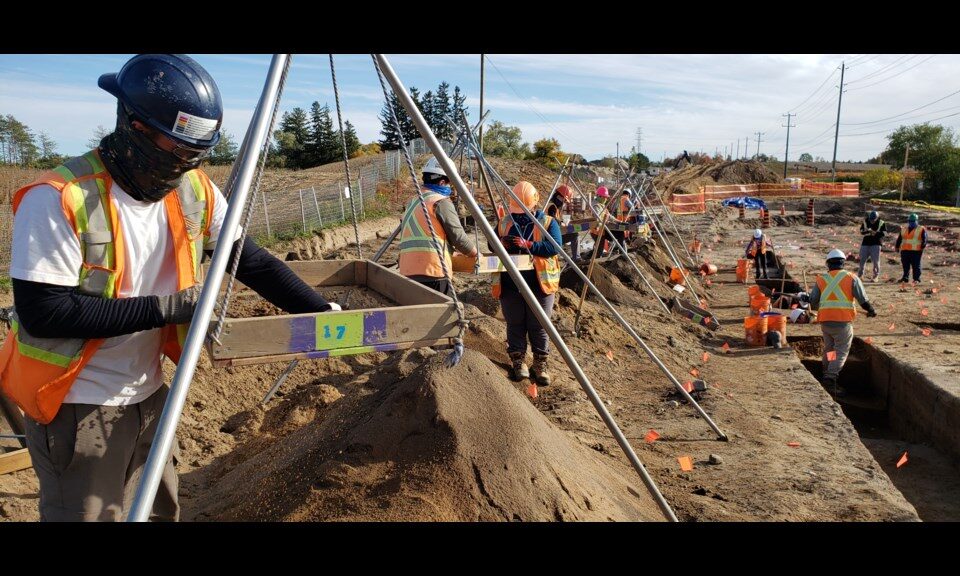Iroquoian Woodland Village Site Discovered in Ontario
Excavation of an Iroquoian village site in southeastern Canada ahead of a road construction project has yielded more than 35,000 artefacts, according to a Kitchener Today report.
Representatives of the Six Nations of the Grand Reserve, the Haudenosaunee Development Institute, and the Mississaugas of the Credit First Nation have been working with archaeologists throughout the process. Archaeologist Barbara Slim said the village has been dated to between A.D. 1300 and 1600.
The village site has yielded over 35,000 to date in the 400 square units that have been excavated. Those one-by-one metre squares of hand sifted soil have included evidence of permanent settlement, ceramics used for cooking and food preparation, stone tools and more.




Associate Archeologist with Wood PLC Barbara Slim said that the company is working closely with the Region of Waterloo as part of the Fischer-Hallman road redevelopment. She said the site was initially uncovered in 2017 in the western end of the property, eventually found to extend to the East through construction monitoring.
“Usually in archaeology when you have a roadway you assume that… that extent of disturbance would completely have removed the site…” said Slim. “… in this case, it did the opposite; it capped it under one-point-eight metres of fill with four layers of asphalt – so we’re in the process of excavating that.”
According to their findings, Slim said the site being excavated is a late woodland village, dated to be from around 1300 to 1600. The investigation has found a permanent settlement with several longhouses, as well as a broad range of artefacts and bone material.
Some of the more interesting items from the excavation include carbonized evidence of bean and corn – a unique find dated to that time period. Also uncovered was a chalcedony projectile point, made from a material not found in Southern Ontario.
“… we know there were a number of different villages within the area – at least four or five that we know of. It is quite important to understand that time period in Ontario archaeology, and to get a better sense of how long we’ve been here,” said Slim. “I should mention we also found an artefact that dates to 4,000 years ago – that just goes to show this was a very important resource area where people were coming back (…) to utilize the resources available.”
Slim said an important part of the work of archaeologists is to work with local indigenous communities to do the work alongside them. The project is accompanied by several Indigenous field liaison representatives – including those from Six Nations of the Grand Reserve, Haudenosaunee Development Institute and Mississaugas of the Credit.
Matthew Muttart is the field director with Wood PLC and has experience working closely with these groups in the excavation process. He said that First Nations groups have brought traditional and cultural perspective to the artefacts being unearthed.
“I’m very fortunate to have them with me in the field because we look at the site and how to proceed together. We discuss our methodology and how we’re going to proceed – and that’s very useful for me,” said Muttart.
Due to the volume of artefacts found, the archaeological work is set to continue for the rest of this construction season, with additional work needing to be completed next year.
It’s expected that excavation costs will be higher than originally estimated, with additional costs for completing road construction work that will now need to be completed later. Excavation staff will be providing an updated report to Regional Council in the new year.
Slim said she’s optimistic that Fischer-Hallman Road will be reopened as planned by the end of 2020 with a 2-lane temporary road cross-section.
In the offseason, Muttart said artefacts will be cleaned, catalogued and analysed to see if they can find any patterns or answer any questions to get a better understanding of the inhabitants of the site.
“We try to engage with the general public with the First Nations groups and try to have the artefacts tell a story, educate people and give a perspective…” said Muttart. “We’re in this part of the world that have been occupied for at least 10,000 years; it has a very rich history and a history that Canadians don’t get a lot of opportunities to learn about…”
“We’re writing the last chapter of this site… so it’s really important that we’re doing it meticulously, giving it the respect and care that the site deserves – as archaeologists, we’re stewards to that’s our charge.”
Archaeologists on site are operating with a modified protocol due to COVID-19 – with teams of three now working separately with masks in order to ensure safe physical distancing. Slim said the important measure has slowed the operation down, but not enough to make a significant dent in the team’s schedule. Local students were also originally set to join the dig team – that measure has been postponed to the Spring should the COVID-19 pandemic be more under control.
“Every day here has been really exciting – every component of the site has evolved in a very unique way. It’s been a very challenging project from the beginning, but very interesting to work with the communities, to work with this great team we have here to unearth what’s preserved…”
